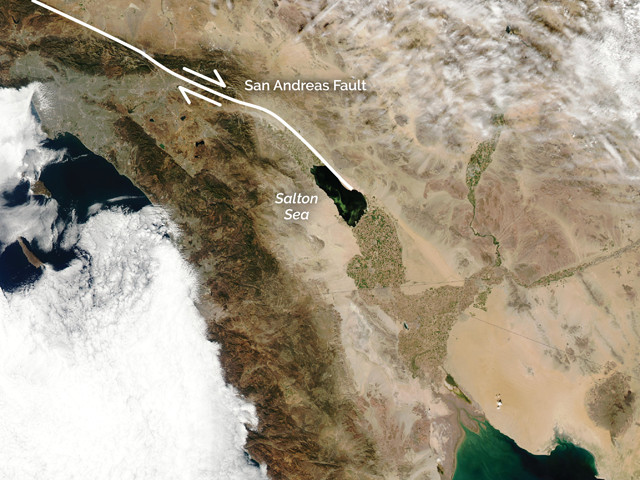
by Lucas Joel Monday, September 10, 2018

In this satellite image of the Salton Sea region of Southern California, the San Andreas Fault Zone can be seen to the east of the sea. This is where researchers say the structure of the fault may be ideal for hosting a very large earthquake. Credit: Jacques Descloitres, MODIS Rapid Response Team, NASA/GSFC.
In 1906, the San Andreas Fault Zone ruptured, and the shaking that followed brought the city of San Francisco to its knees. Buildings toppled and fires raged and, in the end, more than 3,000 people died as a result. Since then, Californians have often wondered aloud when and where the next “Big One” will strike. Geologists do not know the answers, but recent research has offered a new clue: Field mapping of the San Andreas’ southernmost reaches, near the Salton Sea, reveals a type of fault structure that researchers think may be just right for triggering a big earthquake.
The San Andreas Fault Zone (SAFZ) is a roughly 1,300-kilometer-long strike-slip plate boundary that runs from offshore in the north, first makes landfall near Mendocino, Calif., then continues southeast through San Francisco and on until it reaches the Salton Sea southwest of Palm Springs. It was at the Salton Sea that Susanne Jänecke, a tectonicist at Utah State University, discovered something unexpected while she and her team drafted a geologic map of the area — a so-called “Durmid ladder” structure.
The structure, which resembles a ladder in map view, is made of two faults that run alongside each other for about 15 kilometers like the sides of a ladder. And then “there are several cross-faults between the two major faults,” Jänecke says. These cross-faults are the rungs of the ladder, except they are not parallel to one another; toward the base of the ladder they are oriented at a roughly 45-degree angle with respect to the side rails, and this inclination steepens until the rungs are almost parallel with the two major faults toward the top of the sheer zone.
“The San Andreas in this area was thought to be a pretty standard strike-slip fault,” Jänecke says. However, after years of field mapping and analysis of satellite imagery, the ladder structure emerged, rung by sub-parallel rung. “It’s so interesting and complicated,” she says.
To the south of the ladder is a continuation of the plate boundary that the SAFZ forms, with the North American Plate to the east and the Pacific Plate to the west. Geologists call that southern section the Brawley Seismic Zone (BSZ), and Jänecke explains that it is similar in structural complexity to the ladder structure to the north. This could mean trouble when it comes to the next big earthquake to strike on the SAFZ.
“We cannot say where the next big earthquake will start,” says Jänecke, whose team published its results in Lithosphere. But discovering that this stretch of the SAFZ is similar to the BSZ means that, were the next quake to strike near one of these two zones, both zones might fail at once during a single earthquake, which could lead to a quake greater than 7.5 in magnitude. (The 1906 San Francisco earthquake was about magnitude 7.8.)
Jänecke adds that the ladder structure is analogous to the structure of the faults that caused the 2016 Kaikoura earthquake in New Zealand, itself a magnitude-7.8 quake. That quake caused substantial damage, triggered a tsunami and killed two people. The havoc a similar earthquake in California could cause would depend on the direction in which the rupture propagates, Jänecke says. If it traveled northward, then it could approach populated areas in the Coachella Valley. If the rupture traveled southward, toward areas of lower population, the threat would be smaller.
“It’s a really nice study,” says Roland Burgmann, a geophysicist at the University of California, Berkeley, who was not involved in the new work. That the team took field observations and translated them to the scale of broad, regional tectonics is admirable, he says. But it may be too soon to tell how an earthquake would behave given this new structural picture, he adds. This section of the San Andreas is “a logical place” to produce a large quake, he says, but because there are so many little faults in this region, “I find it a little hard to imagine a single big earthquake breaking through there and being completely unstoppable.”
© 2008-2021. All rights reserved. Any copying, redistribution or retransmission of any of the contents of this service without the expressed written permission of the American Geosciences Institute is expressly prohibited. Click here for all copyright requests.